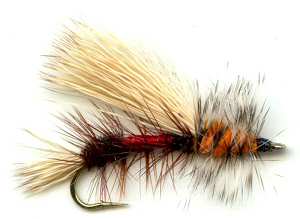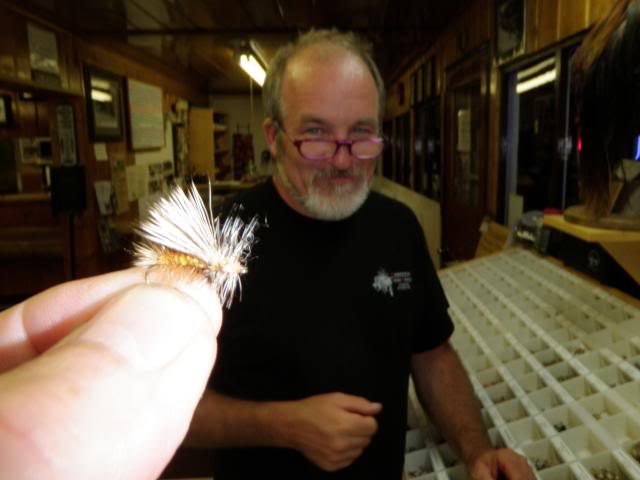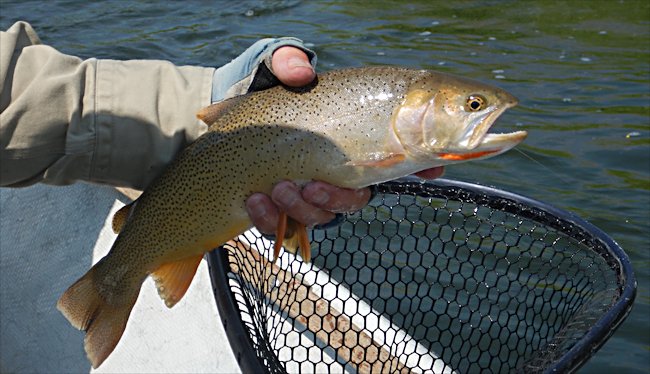Royal Trude Stimulator Attractor Dry Fly
The Royal Trude stimulator is a very good all purpose searching pattern. It is a remarkable ‘attractor’ fly that coaxes reluctant large trout to strike.

STIMULATOR ATTRACTOR SEARCHING DRY FLY PATTERN. Hook size 6 8 10 12 14 16 - $US each
Randell Kaufman has done a lot to expose this style of tying but it did exist well before his variants. He deserves much credit for attaching a name to and the organization of this patterns. The improved Sofa Pillow Patterns are tied using this design. The legendary salmonfly (Peteronarcys californica) is an orange and dark brown monster insect. Why is it legendary? It is this fly that large trout, who are normally reluctant to rise, come straight up to the surface to devour a floating adult salmonfly. Many western North American rivers sprout salmonflies. It tries to imitate an egg-laying female caught on the water and working her wings to escape. That is why the wing is splayed. Fish the fly dead-drift near banks and in shady areas.
When the females begin to fall spent and dying I try to flatten the wing and get it soaking wet before I cast it. I do not use floatant as I am aiming to sink the fly just below the surface. The salmonfly is known by many different names, salmon coloured stoneflies, willow flies, trout flies, or trout bugs. The large nymphs also have a variety of names from Helgrammites to devil scratchers. Western American Fly tiers were slow to develop flies that matched the hatch for the Western Cutthroat trout was even easier to catch than the Eastern Brook trout on standard British and American flies. It wasn’t until the arrival of brown trout from Europe between 1880’s and 1920’s that interest grew in designing flies to match the natural insects. It is also very effective fished with a dropper with a nymph at the end.

This is Jim Slattery in his West Yellowstone Fireside Angler Fishing shop. The original designer of the Stimulator fly pattern
FACEBOOK READER'S COMMENT
Fish across and down, mending the line to make the fly pick up speed as it nears the end of the cast, where you suspect a fish may be lying. Bang! Gregor Fulton McGregor, Hong Kong
FACEBOOK READER'S COMMENT
Often used, mostly out west here in the US, to imitate the salmon fly hatch. hook size 6 Chris Simonds
FACEBOOK READER'S COMMENT
In late spring/early summer this is a killer stonefly pattern on the Deschutes River. In late summer and fall it is a good hopper pattern. Bill Wolford, USA
LINKEDIN COMMENT
What flies work best for Cutthroat Trout? - Royal Trude #16 worked for me in Colorado By Al Schaefer+

CUSTOMER'S PHOTO
Fishing tributaries of the Snake River in Wyoming, the cast is made to the edge of a riffle; the rod tip is then lifted so that the fly skitters across the current. The take is dynamic. Photo is a 14- or 15-inch fine spotted cutthroat trout. It fell to a Royal Trude. Bennett J. Mintz, CA, USA
GOOGLE+ READER'S COMMENT
The Stimi certainty can be used as a great attractor and also to match the hatch as testament to the many sizes and colours its tied in. Being a downwing pattern it best represents stoneflies, terrestrials and larger caddis imitations in the westerner US. I usually start employing them in dark green and black during the long awaited Skwala stonefly hatch which comes after a long winter of tiny mayflies and smuts(midges).They make a fair Salmonfly mock until the fish usually start to discriminate for something a bit more specialized. Again with the beginning of the smaller golden stones. And then they are used almost exclusively to match the lil yellow sallie down to size 16 with a red tail. Occasionally bright stimis make searchers or to have your bug stand out during a very prolific caddis hatch. Though my preference is usually to use another classic the Trude for this application. And. Then finally .... in the hunt for red October they make great Oct caddis in traditional orange from 16 up to 12 depending on the size of the naturals. Markus Fipps, Picabo, USA


Fly Fishing books

